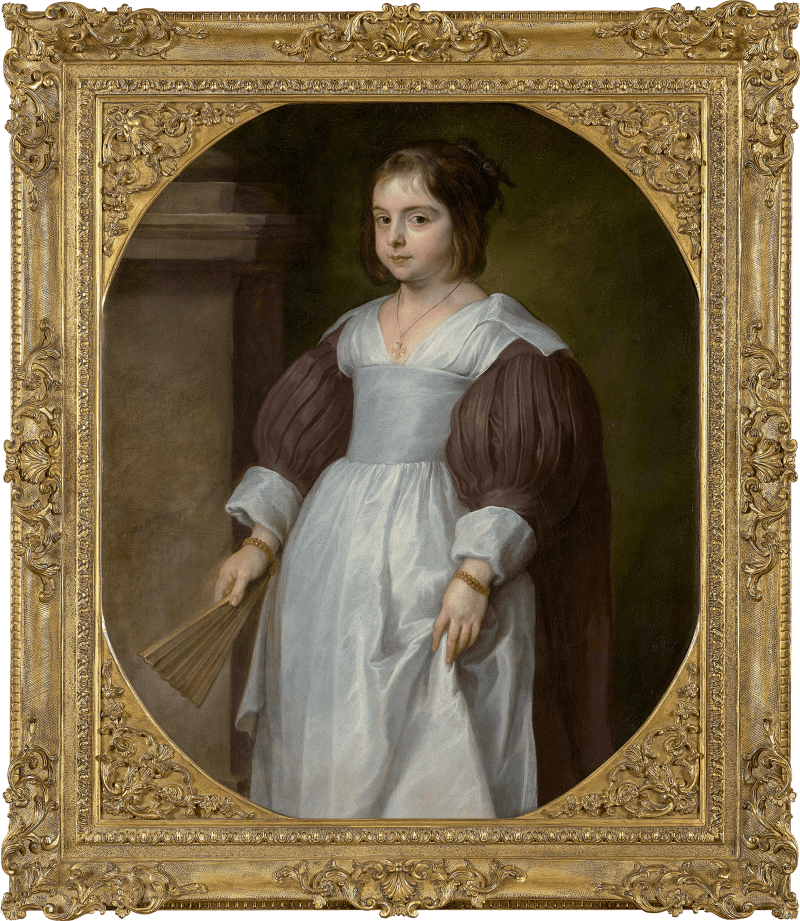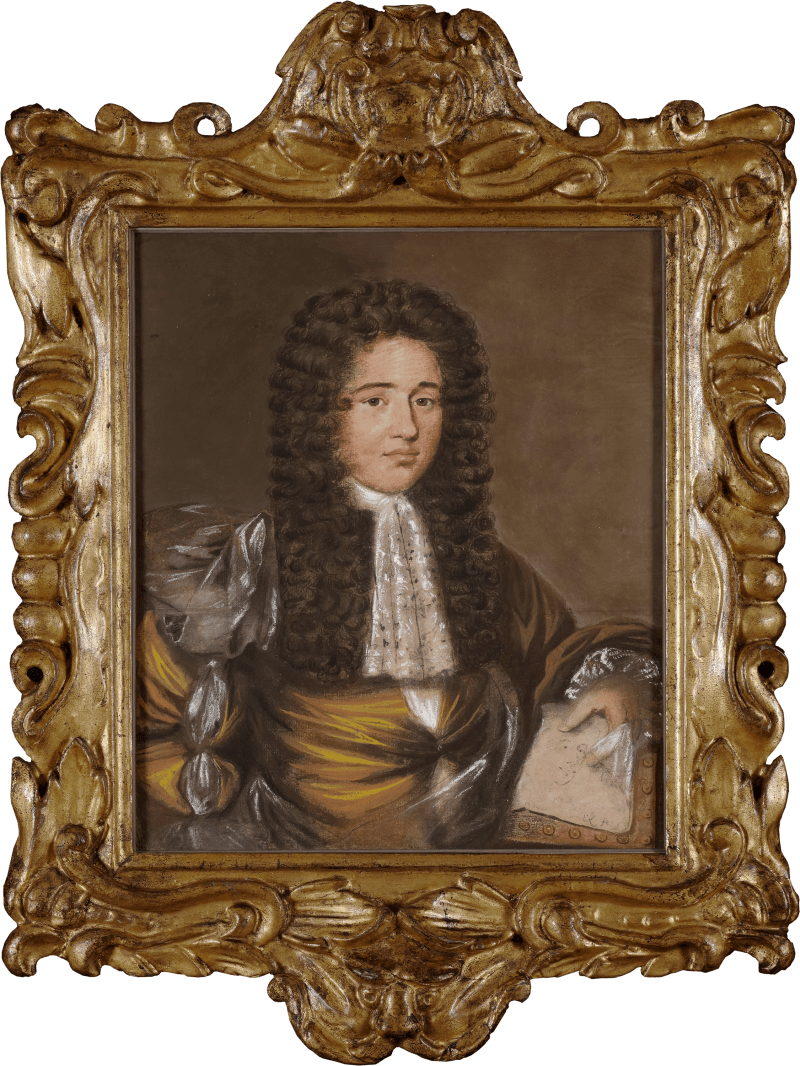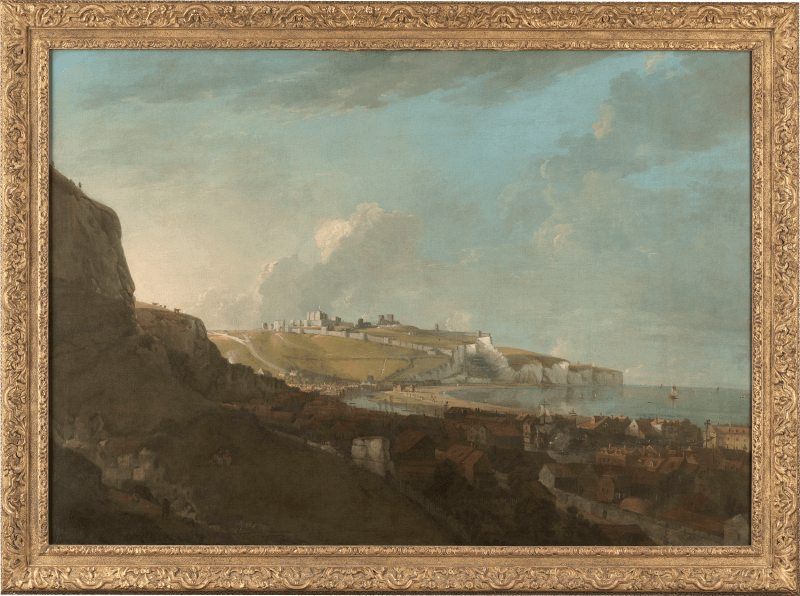We are grateful to Martyn Gregory, leading authority on the art of the China Trade, for his assistance when cataloguing this work.
This portrait of the prominent American trader William Read (1767–1846) was painted in Canton (modern Guangzhou) by the artist known as Spoilum. Exceptionally well-preserved, it stands as one of the finest surviving examples of his work, illustrating the rich cross-cultural exchanges between China and the United States at that date.
By the mid-18th century, Canton, the only Chinese port open to trade during the reign of Qianlong (1735-1796), was an important and lucrative centre for business and trade. European tastes for exotic decorative objects and commodities meant that by the final decades of the eighteenth century, England, Holland, France, Denmark, Sweden, Austria, and Spain had established trading posts in Canton. It was not until 1784, following the signing of the Treaty of Paris, that America entered the China trade, and its first ship landed in 1784...
We are grateful to Martyn Gregory, leading authority on the art of the China Trade, for his assistance when cataloguing this work.
This portrait of the prominent American trader William Read (1767–1846) was painted in Canton (modern Guangzhou) by the artist known as Spoilum. Exceptionally well-preserved, it stands as one of the finest surviving examples of his work, illustrating the rich cross-cultural exchanges between China and the United States at that date.
By the mid-18th century, Canton, the only Chinese port open to trade during the reign of Qianlong (1735-1796), was an important and lucrative centre for business and trade. European tastes for exotic decorative objects and commodities meant that by the final decades of the eighteenth century, England, Holland, France, Denmark, Sweden, Austria, and Spain had established trading posts in Canton. It was not until 1784, following the signing of the Treaty of Paris, that America entered the China trade, and its first ship landed in 1784 laden with Ginseng. The American traders quickly developed an understanding of Chinese tastes, and they soon established a network of trading posts, facilitating the efficient movement of goods to and from Canton.
The sitter in the present work, William Read (1767- 1846), came from a prosperous Pennsylvania family (fig.1). His father, George Read (1733–1798), was a signer of both the Declaration of Independence and the U.S. Constitution, and held successive roles as President of Delaware, U.S. Senator, and Chief Justice of the Delaware Supreme Court. Read, however, decided to pursue a career as a merchant and, in 1789, sailed to Canton on the Union owned by the Philadelphia merchant firm Mordecai Lewis & Co. He then applied to return in 1792 as supercargo (chief commercial officer) aboard the ship Senue, an application supported by his father who recommended him as being of ‘the best disposition, strict integrity and probity’.[2] In 1805, he served as supercargo on the Bingham, a joint venture between Willings & Francis and Willings & Curwen, tasked with procuring tea in Canton.[3] It departed in the spring, carrying $90,000 worth of spices, some of which were exchanged for cotton, blackwood and rattans in Batavia (modern Jakarta) en route.[4] The cargo also included opium, marking this voyage as one of the earliest documented instances of an American opium ship arriving in Canton.[5] Upon arrival, a hong merchant was entrusted with acquiring high-quality tea for shipment to various destinations. The venture ended poorly, however, as the tea was judged inferior and the merchant later claimed that he had never received full payment.[6] Trust was a crucial element of commerce in Canton at this time, since all foreign traders were required to work through the Co-Hong—an association of thirteen Chinese merchants accountable to the emperor who served as their intermediaries in China. Some were regarded as more dependable than others, and the relationships they forged were often significant enough to prompt the commissioning of portraits (fig.2).
It was perhaps during this 1805 visit to Canton that the present portrait was painted. Stylistically, it corresponds to a portrait of Ralph Haskins (1779-1852) of Roxbury, Massachusetts (discussed below), which is known to have been painted by Spoilum in 1803 (fig.3). Although the latter portrait is abraded, it still shows the same firm delineation of the features, along with the distinctive hard shadowing in the necktie. The background, too, is likewise painted in a thick, robust manner with a cool, blueish-green tone applied over a thick white ground, adding luminosity to the overall image.
In his later years, Read was appointed Consul General of the Kingdom of Naples in Philadelphia—a post charged with representing and protecting Neapolitan interests in one of the United States’ principal commercial hubs. Read’s granddaughter later married into the prominent Clymer family - George Clymer (1739-1813), like Read’s father, was also a signer of both the Declaration of Independence and the U.S. Constitution. The present portrait remained in the possession of the Clymer family until it was sold in the 1970s.
The exceptional condition of the present work distinguishes it as not only an important record of this exciting moment of America’s commercial expansion, but as a defining work in the oeuvre of an artist who, although now shrouded in mystery, was evidently much admired by the merchant visitors from the United States and Europe. Spoilum was active in Canton from around 1785 to 1810 and is considered the earliest oil painter in this region, and perhaps in China itself. His style was heavily influenced by Western, specifically American, portraiture, which he was no doubt familiar with through the import of paintings and prints.[7]
Although numerous works by Spoilum have survived, very little is known about the artist.[8] His earliest recorded work is a portrait of a man, probably Captain Thomas Fry, painted on glass and dated 1774 (fig.4). [9] This indicates that he was certainly active by the early 1770s and, in all likelihood, started his career as a reverse glass painter before adopting the medium of oils on canvas the following decade. Reverse glass painting was a thriving trade in Canton during this period, with numerous workshops producing copies of European prints on glass for the Western market (fig.5). An oval portrait in oils, inscribed on the reverse ‘Spoilum/pinxt./ Canton/Decr. 1st 1786’, is a touchstone work in the artist’s oeuvre and is more typical of the style of portraiture we now associate with his hand (fig.?). The oval format was evidently one favoured by Spoilum for his western clients, and numerous examples of this type survive. [10] By this date, his style is distinctive, with his sitters’ features drawn in a crisp, sharp manner, often accompanied by the suggestion of a smile.[11] That Spoilum continued to work on glass is suggested by the existence of unusual work depicting a man named George Harrison with fellow crew members from the ship Alliance, which bears a label on the reverse: ‘G. Harrisons’ – has’d of Spoilum in Canton, AD 1788.’[12] The composition derives from a print by Henry Banbury and was presumably commissioned by Harrison, who was the supercargo aboard the Alliance in 1788.[13]
The most important early written record relating to Spoilum appears in John Meares’ Voyages under January 1788. Meares describes how he had brought to Canton Chief Tianna of Atoor from the Sandwich Islands (Hawaii), who, during his stay, sat for a portrait by Spoilum, who he described as ‘the celebrated artist of China, and perhaps the only one in his line, throughout that extensive empire.’[14] Meares was, presumably, referring to Spoilum’s use of oil paint on canvas, which distinguished him from his contemporaries in Canton who used watercolours. The portrait that Chief Tianna sat for was deemed as a success, though Meares observed that ‘…the painter had indeed most faithfully represented the lineaments of his countenance, but found the graceful figure of the chief beyond the powers of his genius.”[15] Although the original portrait is now lost, it is recorded in an engraving and demonstrates the artist’s versatility at producing works of varying compositional complexity across several different mediums.[16] This is perhaps not surprising, as it can be assumed that painters in Canton at this date would adapt to the trends and demands of their patrons, some of whom may have wanted formal portraits, while others may have preferred port scenes, garden views, or copies of European prints.
We know that Spoilum was still active in Canton at the turn of the century, as in 1803, the Roxbury trader Ralph Haskins (1779-1852) recorded in his diary: ‘while nothing else could be done, I went to Spoilum and sat for two hours for to have my portrait taken. He was $10 each and does a great deal of business in that line. I was surprised to see how expert he was in doing it.[17] This diary entry is interesting, as not only does it reveal that Spoilums fee was aligned with other painters of port scenes and glass painters in Canton at that date, but it also indicates how productive he was, painting a portrait in a two-hour sitting.[18]
The identity of Spoilum has so far eluded scholars. However, it has been suggested that he was Guan Zuolin, an artist noted in a 1910 Cantonese gazetteer as a native of Nanhai and the earliest oil painter in Canton.[19] The publication states that Guan Zuolin was the earliest oil painter in Canton and visited Europe and America, where he admired the realism of oil portraits. He is said to have then opened a painting studio in Canton after his return from abroad in the middle of Jiaqing’s reign (1796-1820), and foreigners were greatly impressed by his superb skill in portrait painting, which was said to be extremely lively.[20] The identification of Spoilum as Guan Zuolin is unlikely, however, not least because the middle of Jiaqing’s reign would have been around 1810. By this stage, as evidenced by the aforementioned surviving inscribed works, Spoilum was already working in a distinctly European style. Furthermore, a member of the Guan family purportedly told a curator at the Hong Kong Museum of Art that Guan Zuolin was also known as Lamqua, which would identify him as the follower of Spoilum by that name who was active in Canton in 1820.[21]
[1] It seems likely that the present work followed the same line of descent to Sally Read Fisher as the portrait of George Clymer (1739-1813) after Charles Willson Peale (1741 – 1827) in the National Portrait Gallery, Smithsonian Institution (NPG.72.5). It is known that it was in the possession her nephew, Dr George Clymer (1883-1953).
[2] William T. Read, Life and Correspondence of Gauge Rad (Philadelphia, 1870), p. 550
[3] “Willings and Francis Records 1698-1855, Collection 1874,” The Historical Society of Pennsylvania, p. 1, accessed 7 October 2025, https://hsp. org/sites/default/files/legacy_files/migrated/ findingaid1874willingsandfrancis.pdf [4] ibid [5] “Years of Rebound and Opium, 1815-1828,” Scholarly Publications Universiteit Leiden, accessed 7 October 2025, https://scholarlypublications.... access/item:2963191/view. This is also one of the few recorded transactions in which a hong merchant bought opium. Eleven boxes were acquired from the Bingham shipment for $11,972 on 28 December 1805. See Account of sales of opium from the ship Bingham dated Canton 28 December 1805, Willings & Francis Papers, 1805 folder, Historical Society of Pennsylvania, reproduced in Jonathan Goldstein, ‘Resources on Early Sino-American Relations in Philadelphia’s Stephen Girard Collection and the Historial Society of Pennsylvania’, Ch’ing-shih we-t’i, vol. 4, 1980, pp. 114, 121 [6] “Willings and Francis Records 1698-1855, Collection 1874,” The Historical Society of Pennsylvania, accessed 7 October 2025, https://hsp.org/ sites/default/files/legacy_files/migrated/ findingaid1874willingsandfrancis.pdf
[7] Iside Carbone, Glimpses of China Through the Export Watercolours of the 18th-19th Centuries: A Selection from the British Museum’s Collection, (masters thesis, University of London, 2002), p. 27. Accessed 5 October 2025, https:// soas-repository.worktribe.com/output/414961
[8] The first substantial discussion of Spoilum as a portraitist of American and English merchants and captains appeared in Carl L. Crossman’s The China Trade (Princeton, 1972) and was later expanded in the updated edition The Decorative Arts of The China Trade, (Woodbridge, 1991).
[9] Previously with Martyn Gregory Gallery and illustrated in Crossman, 1991, pl. 3, p. 34
[10] Examples include the portraits of a member of the East India Company, c. 1800, and a man from Dorchester, Massachusetts, c. 1880, reproduced in Crossman, 1991, pl. 10, p. 45, and pl. 12, p. 48
[11] Several oval portraits by Spoilum survive on their original laminated stretchers, constructed by fusing long strips of thin wood and bending them into an oval shape over which the canvas was stretched.
[12] Exhibited in Philadelphians and the China Trade 1784- 1844, Philadelphia Museum of Art, 1984. Illustrated in Jean G. Lee, Philadelphians and the China Trade 1784-1844, (exh. cat., Philadelphia, 1984), cat. 208, p. 192 [13] Carl L. Crossman’s The China Trade (Woodbridge, 1972), p. 35.
[14] John Meares, Voyages made in the years 1788 and 1789, from China to the North West Coast of America … (London, 1790), p. 141. Quoted in Quoted in Crossman, 1991, p. 36.
[15] John Meares, Voyages made in the years 1788 and 1789, from China to the North West Coast of America … (London, 1790), p. 141. Quoted in Quoted in Crossman, 1991, p. 36
[16] The engraving was published in John Meares, Voyages made in the years 1788 and 1789, from China to the North West Coast of America (London, 1790), p. 5.
[17] Diary of Ralph Haskins of Roxbury, Massachusetts, kept at Canton, 1802, privately owned. Quoted in Crossman, 1991, p. 49
[18] The portrait of Haskins was in the collection of Mr and Mrs Michael Treacy as of 1991 and is illustrated in Crossman, 1991, p. 43
[19] Crossman, 1991, pp. 42-44
[20] Joseph Ting, Late Qing China Trade Paintings (Hong Kong Museum of Art, 1982), p. 10. Quoted in Crossman, 1991, p. 44
[21] Crossman, 1991, p. 44. For further information on Lamqua see ‘The Followers of Spoilum’ in Crossman, 1991, pp. 54-71

























